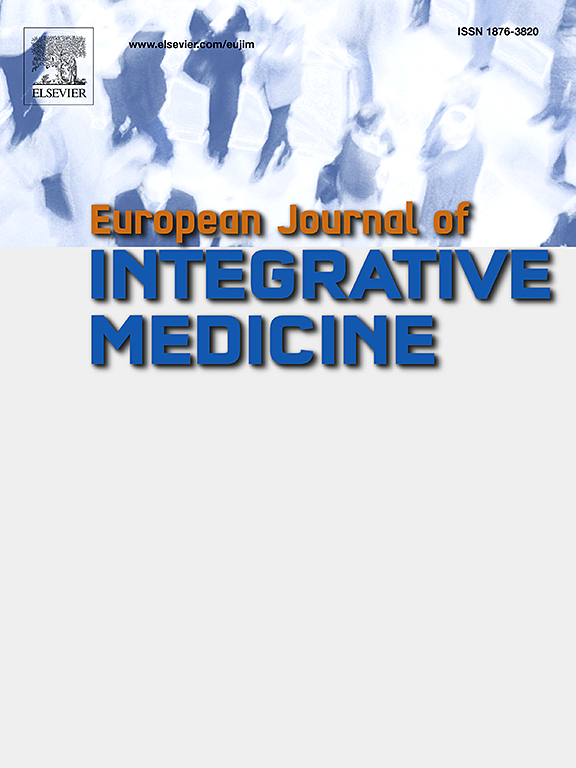Efficacy and safety of Tanreqing injection in ventilator-associated pneumonia: A systematic review and meta-analysis
IF 1.7
4区 医学
Q3 INTEGRATIVE & COMPLEMENTARY MEDICINE
引用次数: 0
Abstract
Introduction
Ventilator-associated pneumonia (VAP), a prevalent complication of mechanical ventilation, severely impacts patients' quality of life and increases mortality. This systematic review aimed to assess the effectiveness and safety of Tanreqing injection—an injectable herbal preparation with antibacterial, anti-inflammatory, and immunomodulatory properties—as an adjunctive therapy for VAP.
Methods
We searched seven databases up to October 6, 2024, to identify randomized controlled trials (RCTs) of Tanreqing injection plus routine treatment versus routine treatment alone for treating VAP. Two reviewers independently performed literature screening and data extraction. The risk of bias of the included studies was assessed using the Cochrane Risk of Bias Tool 2. Effects were measured using risk ratios (RRs) or mean differences (MDs) with 95% confidence intervals (CIs).
Results
Twenty-two RCTs involving 1,536 patients were included (7, 12, and 3 RCTs with low, moderate, and high risk of bias, respectively). Compared with the control, Tanreqing injection significantly reduced the duration of mechanical ventilation (MD −1.72 d, CIs −2.32 to −1.13), mortality (RR 0.34, CIs 0.15 to 0.78), response rate to treatment (RR 1.19, CIs 1.12 to 1.26), white blood cell count (MD −2.14 × 109/L, CIs −2.89 to −1.39), procalcitonin level (MD −0.42 ng/mL, CIs −0.68 to −0.15), C-reactive protein level (MD −15.51 mg/L, CIs −20.68 to −10.35), duration of antibiotic use (MD −3.67 d, CIs −5.43 to −1.90), and length of intensive care unit (ICU) stay (MD: −3.68 d, CIs −5.26 to −2.09). No adverse events related to Tanreqing injection were reported.
Conclusions
Tanreqing injection, when used as an adjuvant therapy to the routine treatment of VAP, can reduce mechanical ventilation duration, antibiotic use, length of ICU stay, mortality, and inflammation indicator levels. More well-designed RCTs are needed to corroborate these findings because of the moderate-to-high risk of bias among the included RCTs.
痰热清注射液治疗呼吸机相关性肺炎的疗效和安全性:一项系统综述和荟萃分析
呼吸机相关性肺炎(VAP)是机械通气的一种常见并发症,严重影响患者的生活质量并增加死亡率。本系统综述旨在评估痰热清注射液作为VAP辅助治疗的有效性和安全性。痰热清注射液是一种具有抗菌、抗炎和免疫调节特性的注射用草药制剂。方法检索截至2024年10月6日的7个数据库,筛选痰热清注射液联合常规治疗与单独常规治疗治疗VAP的随机对照试验(rct)。两位审稿人独立进行文献筛选和数据提取。纳入研究的偏倚风险使用Cochrane风险偏倚工具2进行评估。使用95%置信区间(ci)的风险比(rr)或平均差异(MDs)来衡量效果。结果共纳入22项随机对照试验,共1536例患者(低、中、高偏倚风险分别为7项、12项和3项)。与对照组相比,热清注射液显著降低了机械通气时间(MD - 1.72 d, CIs - 2.32 ~ - 1.13)、死亡率(RR 0.34, CIs 0.15 ~ - 0.78)、治疗有效率(RR 1.19, CIs 1.12 ~ 1.26)、白细胞计数(MD - 2.14 × 109/L, CIs - 2.89 ~ - 1.39)、降钙素原水平(MD - 0.42 ng/mL, CIs - 0.68 ~ - 0.15)、c反应蛋白水平(MD - 15.51 mg/L, CIs - 20.68 ~ - 10.35)、抗生素使用时间(MD - 3.67 d, CIs - 5.43 ~ - 1.90)。重症监护病房(ICU)住院时间(MD:−3.68 d, ci:−5.26 ~−2.09)。未见痰热清注射液相关不良事件的报道。结论痰热清注射液作为VAP常规治疗的辅助治疗,可减少机械通气时间、抗生素使用、ICU住院时间、死亡率和炎症指标水平。由于纳入的随机对照试验存在中高偏倚风险,需要更多设计良好的随机对照试验来证实这些发现。
本文章由计算机程序翻译,如有差异,请以英文原文为准。
求助全文
约1分钟内获得全文
求助全文
来源期刊

European Journal of Integrative Medicine
INTEGRATIVE & COMPLEMENTARY MEDICINE-
CiteScore
4.70
自引率
4.00%
发文量
102
审稿时长
33 days
期刊介绍:
The European Journal of Integrative Medicine (EuJIM) considers manuscripts from a wide range of complementary and integrative health care disciplines, with a particular focus on whole systems approaches, public health, self management and traditional medical systems. The journal strives to connect conventional medicine and evidence based complementary medicine. We encourage submissions reporting research with relevance for integrative clinical practice and interprofessional education.
EuJIM aims to be of interest to both conventional and integrative audiences, including healthcare practitioners, researchers, health care organisations, educationalists, and all those who seek objective and critical information on integrative medicine. To achieve this aim EuJIM provides an innovative international and interdisciplinary platform linking researchers and clinicians.
The journal focuses primarily on original research articles including systematic reviews, randomized controlled trials, other clinical studies, qualitative, observational and epidemiological studies. In addition we welcome short reviews, opinion articles and contributions relating to health services and policy, health economics and psychology.
 求助内容:
求助内容: 应助结果提醒方式:
应助结果提醒方式:


